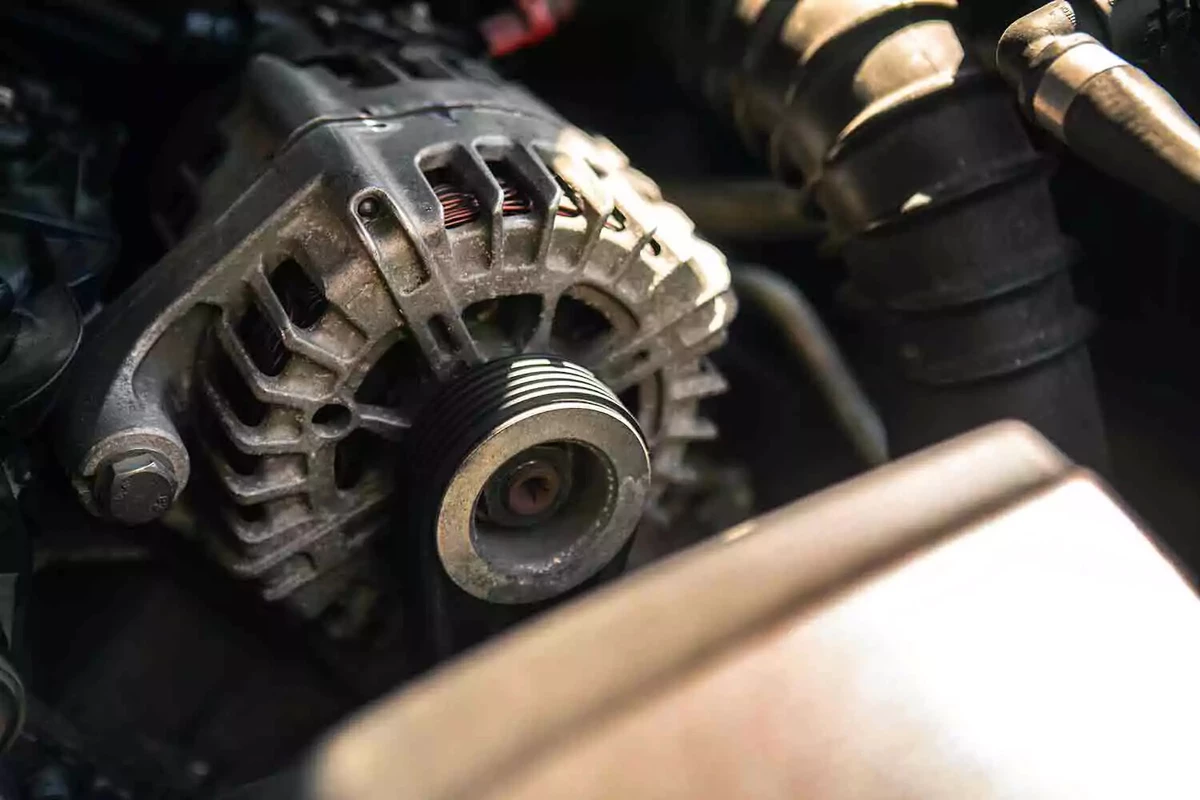To understand how the battery and charging system works, it’s essential to explore the purpose and function of the car alternator - opens in new window or tab.. If your alternator is failing, your car’s battery won’t remain charged, and the critical accessories won’t receive the power they need to run. So, how do you diagnose a failing alternator?
How an Alternator Works

The alternator generates the electrical power your car needs and recharges the battery when the engine is running.
Your alternator is a critical electrical system component. The alternator converts the mechanical energy from the engine into electrical energy. In a typical car or truck, here’s how the alternator works.
- A belt connected to the engine’s crankshaft drives the alternator’s pulley while the motor is running.
- The pulley operates a rotor inside the alternator.
- The rotor is an electromagnet that spins inside stationary wire coils—called the stator—to create a magnetic field.
- This interaction between the stator coils and the rotating magnetic field creates an alternating current (AC).
- The built-in rectifier and voltage regulator turn the AC power into direct current (DC).
- DC power is used by your car’s electrical systems, such as the radio, air conditioning, and headlights. It’s also used to recharge the battery.
The voltage generated by the alternator typically is between 13.8 and 14.4 volts. The alternator’s voltage regulator ensures that just the right amount of voltage is sent to the battery. It prevents overcharging and promotes optimal performance of the electrical system.
How Long an Alternator Lasts

Age and mileage aren’t the only factors that determine if an alternator needs to be replaced.
The typical alternator should last between 75,000 and 150,000 miles. That’s about seven to 10 years of driving. But age and mileage aren’t the only factors that determine if an alternator needs to be replaced. Here are reasons that an alternator fails prematurely.
Contamination: Moisture, dirt, and oil can contaminate and damage the electrical connections in the alternator or wear out its bearings.
Excessive heat: If the engine gets too hot, it can degrade the alternator’s internal components, causing the whole alternator to fail prematurely.
Faulty wiring or connections: If the voltage regulator within the alternator goes bad, it will wear out the whole alternator. Faulty wiring can also cause irregular charging, which will overwork and wear out the alternator.
Misaligned serpentine belt: A misaligned or slipping belt accelerates wear on the alternator.
Overloading: High-power or aftermarket accessories can put too much strain on your car’s electrical system. That demand can wear out the alternator.
How long should a car will run with a bad alternator?
If the alternator quits while you are driving, you may still be able to go a short distance, but you could break down without warning. Your car is running on battery power alone. If your battery is in good condition and charged, you may be able to drive for 30 minutes or more, depending on how much electrical supply the car needs for accessories.
Eventually, the car is going to stall. Be prepared to drive to a safe location.
Alternator Warning Signs

If the battery warning light is lit, take heed.
The first thing you may notice is trouble starting your car. A failing alternator can’t charge the battery. You may also notice the battery warning light on the dashboard (it may say ALT) that tells you there’s an issue with the charging system. The headlights and dashboard lights may flicker as the battery dies, and you might notice problems with the other power accessories, such as the radio, power windows, or air conditioning.
A bad alternator can also make strange noises, often resembling a whining or grinding sound. These are caused by internal damage, such as worn bearings. If the alternator is overcharging the battery or overheating, it could lead to a burning smell.
It’s good to know the signs of a bad car battery verus a bad alternator. But it’s better to know how to test an alternator so you can determine the cause. A voltmeter test can differentiate between a bad battery and a bad alternator, saving you time and money on the replacement.
How do you replace a car alternator?
It’s not difficult to replace a car alternator if you have the right tools. It should take between one and two hours.
See our detailed step-by-step guide and video for replacing an alternator - opens in new window or tab..
How much does it cost to replace an alternator?
A new alternator with a warranty from the manufacturer may cost between $200 and $400. A new alternator lasts longer and is usually worth the cost.
You can also find rebuilt alternators for a fraction of the price, but these may not be available with a warranty or last as long as a brand-new unit. Used alternators may be a good bargain-friendly option if they are high-quality. Look for sellers on eBay with a good return policy and a warranty for added protection.
Finally, consider an alternator rebuild kit, usually costing $50 or less. These kits include the components needed to rebuild the alternator, such as resistors, rectifiers, diodes, brushes, and bearings. It is affordable but takes a lot of time and work. While there was a time when this was standard practice, most people now prefer to replace the whole alternator as a unit. It’s simpler and less time-consuming.
What Else to Replace When You Change a Car Alternator

It’s always wise to install a new serpentine belt when replacing an alternator.
You may want to replace your car battery - opens in new window or tab. at the same time as the alternator. If the alternator has been supplying too much voltage to the battery, it could have led to excessive wear.
While replacing the alternator, inspect the corresponding parts for wear. Inspect the serpentine belt (drive belt) - opens in new window or tab., tensioner - opens in new window or tab., and idler pulleys - opens in new window or tab. to see if any are damaged or failing. If so, replace these at the same time.
Share your feedback
This article is meant to provide general guidance only. Automotive maintenance, repair, upgrade, and installation may depend on vehicle-specifics such as make and model. Always consult your owner's manual, repair guide for specific information for your particular vehicle and consider a licensed auto-care professional's help as well, particularly for advance repairs.
